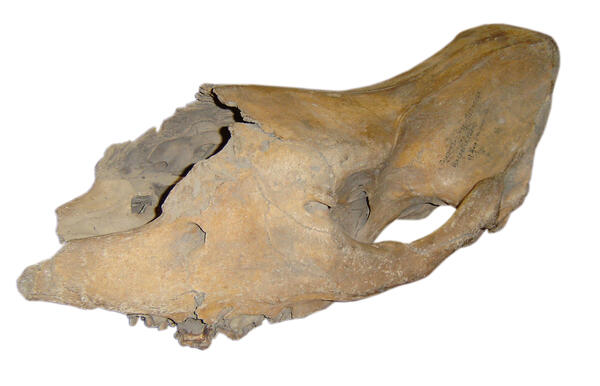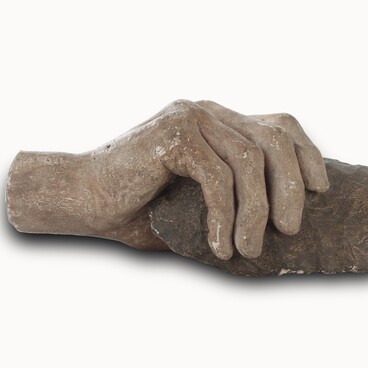The Kursk Regional Museum of Archaeology houses a skull of a woolly rhinoceros found in the 1920s in Shchigrovsky uyezd (the Kursk region). The woolly rhinoceros (Coelodonta antiquitatis) is an extinct species of rhinoceros that lived during the Ice Age, 300,000 — 10,000 years ago.
In its heyday (about 130,000 years ago), the woolly rhinoceros inhabited all of Europe (excluding southern Scandinavia, the south of the Iberian Peninsula and Ireland), the Russian Plain, in the southern parts of the western and eastern Siberia, Primorye, Mongolia and northern China. According to descriptions by paleontologists, the woolly rhinoceros was a very large animal. Its height at the shoulders was about 1.5 m, reaching 1.9 or even 2 m in large specimens, and body length up to 4.5 m. Large rhinos could weigh up to 3.5 tons. Thus, the woolly rhinoceros was, on average, equal in weight and size to the modern African black rhinoceros, and the largest individuals were not smaller than the white rhinoceros.
The maximum lifespan of rhinoceroses was 40–45 years. Despite the general resemblance to its modern relatives, the woolly rhinoceros was shorter-legged and its body was much more elongated. The legs, like those of modern rhinoceroses, were three-toed. The neck of the woolly rhinoceros was raised by a powerful hump, which was formed by strongly developed muscles designed to support the weight of the huge horn and take the load of horn hitting the ground while feeding. The hump also contained a significant amount of fat, essential as a reserve of nutrients in case of starvation. The animal’s body was covered with long reddish-brown fur, sometimes with a yellowish tint. Under coarse covering hair there was a thin dense undercoat, on the withers and neck there was something like a mane of long and stiff hair, and limbs were covered with shorter hair. The body had a tail of 45–50 cm with a tassel of coarse hair at the end.
The skin of the woolly rhinoceros was very thick, which also reduced heat loss from the body. Its thickness on different parts of the body varied from 5 to 15 mm, and it was thickest on the chest and shoulders. The woolly rhinoceros most likely, similarly to modern rhinoceroses, led a solitary lifestyle, without forming herds or groups. It probably grazed most of the time in the richest forage areas in river valleys and near water bodies. The broad upper lip indicates that the rhinoceros fed mainly on grass and other vegetation, which had to be plucked directly from the ground.
In its heyday (about 130,000 years ago), the woolly rhinoceros inhabited all of Europe (excluding southern Scandinavia, the south of the Iberian Peninsula and Ireland), the Russian Plain, in the southern parts of the western and eastern Siberia, Primorye, Mongolia and northern China. According to descriptions by paleontologists, the woolly rhinoceros was a very large animal. Its height at the shoulders was about 1.5 m, reaching 1.9 or even 2 m in large specimens, and body length up to 4.5 m. Large rhinos could weigh up to 3.5 tons. Thus, the woolly rhinoceros was, on average, equal in weight and size to the modern African black rhinoceros, and the largest individuals were not smaller than the white rhinoceros.
The maximum lifespan of rhinoceroses was 40–45 years. Despite the general resemblance to its modern relatives, the woolly rhinoceros was shorter-legged and its body was much more elongated. The legs, like those of modern rhinoceroses, were three-toed. The neck of the woolly rhinoceros was raised by a powerful hump, which was formed by strongly developed muscles designed to support the weight of the huge horn and take the load of horn hitting the ground while feeding. The hump also contained a significant amount of fat, essential as a reserve of nutrients in case of starvation. The animal’s body was covered with long reddish-brown fur, sometimes with a yellowish tint. Under coarse covering hair there was a thin dense undercoat, on the withers and neck there was something like a mane of long and stiff hair, and limbs were covered with shorter hair. The body had a tail of 45–50 cm with a tassel of coarse hair at the end.
The skin of the woolly rhinoceros was very thick, which also reduced heat loss from the body. Its thickness on different parts of the body varied from 5 to 15 mm, and it was thickest on the chest and shoulders. The woolly rhinoceros most likely, similarly to modern rhinoceroses, led a solitary lifestyle, without forming herds or groups. It probably grazed most of the time in the richest forage areas in river valleys and near water bodies. The broad upper lip indicates that the rhinoceros fed mainly on grass and other vegetation, which had to be plucked directly from the ground.



